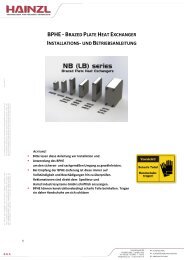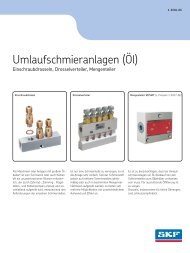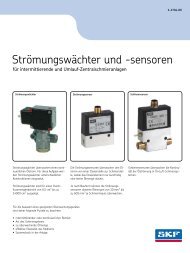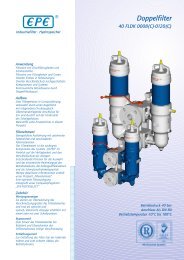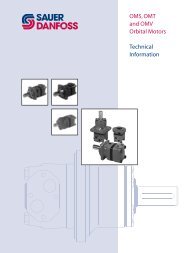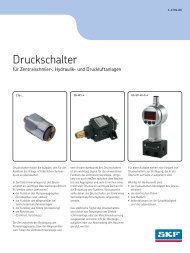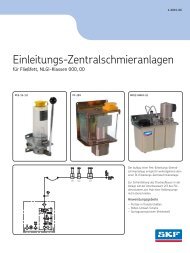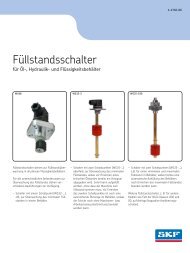Turolla group 3 gear pumps - technical information - bibus sk
Turolla group 3 gear pumps - technical information - bibus sk
Turolla group 3 gear pumps - technical information - bibus sk
Create successful ePaper yourself
Turn your PDF publications into a flip-book with our unique Google optimized e-Paper software.
OpenCircuitGear<br />
<br />
MEMBER OF THE SAUER-DANFOSS GROUP<br />
Group 3 Gear Pumps<br />
Technical Information<br />
System Requirements<br />
Hydraulic fluids<br />
Ratings and data for SNP3NN and SEP3NN <strong>gear</strong> <strong>pumps</strong> are based on operating with<br />
premium hydraulic fluids containing oxidation, rust, and foam inhibitors. These fluids<br />
must possess good thermal and hydrolytic stability to prevent wear, erosion, and<br />
corrosion of internal components. They include:<br />
• Hydraulic fluids following DIN 51524, part 2 (HLP) and part 3 (HVLP) specifications<br />
• API CD engine oils conforming to SAE J183<br />
• M2C33F or G automatic transmission fluids<br />
• Certain agricultural tractor fluids<br />
Use only clean fluid in the pump and hydraulic circuit.<br />
C Caution<br />
Never mix hydraulic fluids.<br />
Please see <strong>Turolla</strong> OCG publication Hydraulic Fluids and Lubricants Technical<br />
Information, L1021414 for more <strong>information</strong>. Refer to publication Experience<br />
with Biodegradable Hydraulic Fluids Technical Information, L1021903 for<br />
<strong>information</strong> relating to biodegradable fluids.<br />
Temperature and<br />
Viscosity<br />
Temperature and viscosity requirements must be concurrently satisfied. Use<br />
petroleum / mineral-based fluids.<br />
High temperature limits apply at the inlet port to the pump. The pump should run at<br />
or below the maximum continuous temperature. The peak temperature is based on<br />
material properties. Don’t exceed it.<br />
Cold oil, generally, doesn’t affect the durability of pump components. It may affect the<br />
ability of oil to flow and transmit power. For this reason, keep the temperature at 16 °C<br />
[60 °F] above the pour point of the hydraulic fluid.<br />
Minimum (cold start) temperature relates to the physical properties of component<br />
materials.<br />
Minimum viscosity occurs only during brief occasions of maximum ambient temperature<br />
and severe duty cycle operation. You will encounter maximum viscosity only at cold start.<br />
During this condition, limit speeds until the system warms up. Size heat exchangers to<br />
keep the fluid within these limits. Test regularly to verify that these temperatures and<br />
viscosity limits aren’t exceeded. For maximum unit efficiency and bearing life, keep the<br />
fluid viscosity in the recommended viscosity range.<br />
Fluid viscosity<br />
Maximum (cold start)<br />
1000 [4600]<br />
mm 2 /s<br />
Recommended range 12-60 [66-290]<br />
[SUS]<br />
Minimum 10 [60]<br />
Temperature<br />
Minimum (cold start)<br />
-20 [-4]<br />
°C<br />
Maximum continuous 80 [176]<br />
[°F]<br />
Peak (intermittent) 90 [194]<br />
L1016456 • June 2010 • Rev A<br />
11



